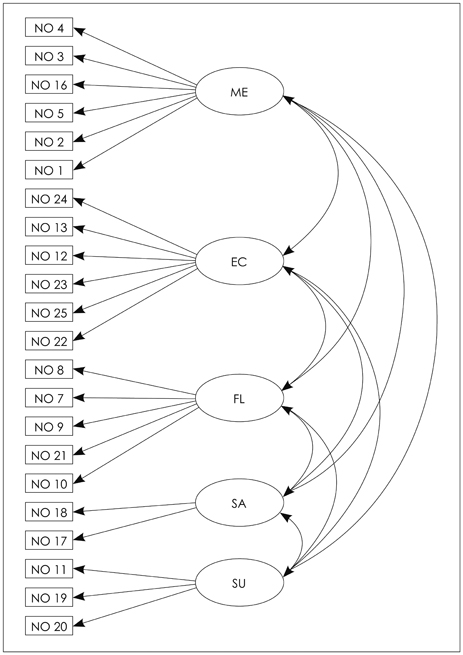J Korean Neuropsychiatr Assoc.
2013 Nov;52(6):431-441.
Revision of the Mental Fitness Scale : Validation and Confirmatory Factor Analysis
- Affiliations
-
- 1Yongmoon Graduate School of Counseling Psychology, Seoul, Korea.
- 2Department of Psychiatry, Seoul Paik Hospital, Inje University School of Medicine, Seoul, Korea. jongmin.woo@gmail.com
- 3Stress Research Institute, Inje University, Seoul, Korea.
Abstract
OBJECTIVES
The purpose of this study was to correct the statistical errors in the previous article on "The Development of the 'Mental Fitness' Scale" (MFS) and to confirm the validity of factor structure via confirmatory factor analysis.
METHODS
Based on re-analysis of the factor structure of 25 preliminary items using the original dataset, we identified 22 items of the MFS and assessed test-retest reliability. Concurrent validity was assessed by correlating the new set of MFS with total scores of the Beck Depression Inventory and Positive and Negative Affect Schedule. We also performed confirmatory factor analysis (CFA) in order to verify the factor structure resulting from the exploratory factor analysis.
RESULTS
Re-analysis yielded five factors of 22 items, which is different from four factors of 20 items in the previous paper. 'Self-understanding' was added as one of the five factors. The test-retest reliability coefficients were significantly high, ranging between 0.57-0.73. Internal consistency was computed, and Cronbach's alpha for five factors ranged between 0.67-0.86, and was 0.91 for the total score. Concurrent validity and discriminant validity were both significant. The validity of five factor structure based on CFA was verified as root mean square error of approximation was significant.
CONCLUSION
Based on results of confirmatory factor analysis, the validity and utility of the revised MFS was increased.
Figure
Reference
-
1. Cho SH, Woo JM, Kim W, Byun KR, Kang EH, Choi SW, et al. The Development of the 'mental fitness' Scale. J Korean Neuropsychiatr Assoc. 2011; 50:116–124.2. Park KB. Multivariate Analysis. Seoul: Hakjisa;2000.3. Lee SM. Basics of Factor Analysis. Seoul: EducationScience Books;2000.4. Watson D, Clark LA, Tellegen A. Development and validation of brief measures of positive and negative affect: the PANAS scales. J Pers Soc Psychol. 1988; 54:1063–1070.
Article5. Lee HH, Kim EJ, Lee MK. A validation study of Korean positive and negative affect schedule: The PANAS scales. Korean J Clin Psych. 2003; 22:935–946.6. Beck AT, Steer RA. Beck depression inventory manual. San Antonio: Psychological Corporation;1993.7. Lee YH, Song JY. A study of the reliability and the validity of the BDI, SDS, and MMPI-D Scales. Korean J Clin Psychol. 1991; 10:98–113.8. Anderson JC, Gerbing DW. Structural equation modeling in practice: a review and recommended two-step approach. Psychol Bull. 1988; 103:411–423.
Article9. Bae RB. Structural Equation Modeling With AMOS 7: Basic Concepts, Applications. Seoul: ChungRam Books;2007.10. Sung TJ. Item Analysis : Theory and Practice. Seoul: Hakjisa;1996.11. Ebel RL. Measuring educational achievement. Englewood Cliffs, NJ: Prentice-Hall;1965.12. Hong SH. The criteria for selecting appropriate fit indices in structural equation modeling and their rationales. Korean J Clin Psychol. 2000; 19:161–177.13. Ryan RM, Frederick C. On energy, personality, and health: subjective vitality as a dynamic reflection of well-being. J Pers. 1997; 65:529–565.
Article14. Diener E. Subjective well-being. Psychol Bull. 1984; 95:542–575.
Article15. Ryff CD. Psychological well-being in adult life. Curr Direct Psychol Sci. 1995; 4:99–104.
Article16. Salovey P, Mayer JD. Emotional intelligence. Imaging Cogn Person. 1990; 9:185–211.
Article17. Peterson C, Seligman MEP. Character strengths and virtues: A handbook and classification. New York: Oxford University Press;2004.18. Lopes PN, Brackett MA, Nezlek JB, Schütz A, Sellin I, Salovey P. Emotional intelligence and social interaction. Pers Soc Psychol Bull. 2004; 30:1018–1034.
Article19. Der Foo M, Elfenbein HA, Tan HH, Aik VC. Emotional intelligence and negotiation: the tension between creating and claiming value. Intern J Confl Manag. 2004; 15:411–429.
Article20. Costa PT, McCrae RR. Neo PI-R professional manual. Odessa, FL: Psychological Assessment Resources;1992. Vol 396.21. Keyes CL, Shmotkin D, Ryff CD. Optimizing well-being: the empirical encounter of two traditions. J Pers Soc Psychol. 2002; 82:1007–1022.
Article22. White K, Lehman DR. Culture and social comparison seeking: the role of self-motives. Pers Soc Psychol Bull. 2005; 31:232–242.
Article23. Diener E, Diener M, Diener C. Factors predicting the subjective well-being of nations. J Pers Soc Psychol. 1995; 69:851–864.
Article24. Goleman D. What Makes a Leader?. In : Porter LW, Angle HL, Allen RW, editors. Organizational Influence Processes. 2nd ed. New York: ME Sharpe;2003. p. 229–241.25. Kang SH. Reliability. Seoul: Kyoyook Book;2004.26. Crawford CB. Determining the number of interpretable factors. Psychol Bull. 1975; 82:226–237.
Article27. Zwick WR, Velicer WF. Comparison of five rules for determining the number of components to retain. Psychol Bull. 1986; 99:432–442.
Article
- Full Text Links
- Actions
-
Cited
- CITED
-
- Close
- Share
- Similar articles
-
- Validation of the Korean version of the Mental Health Literacy Scale
- The Validation Study of the Korean Version of Self-Compassion Scale with Adult Women in Community
- A Validation Study for the Scale of the Media Reports Regarding Suicide
- The Development and Validation of the Perceived Competence Scale for Disaster Mental Health Workforce
- Validation and Reliability of Korean Short Version of the Perspectives on Caring for Older Patients Scale


